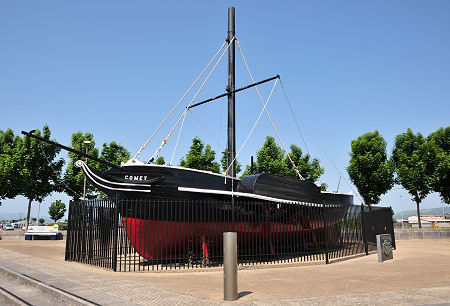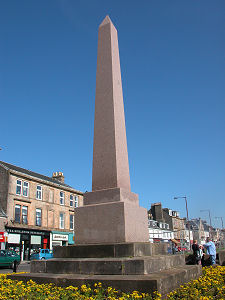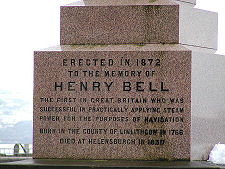 Replica of the Comet in Port Glasgow |
Henry Bell lived from 7 April 1767 to 14 March 1830. He made his name by building the the paddle steamer PS Comet and, in 1812, using it to run Europe's first commercially viable passenger steamboat service on the River Clyde between Glasgow and Greenock. The wider picture in Scotland at the time is set out in our Historical Timeline.
Bell was born in Torphichen in West Lothian. After leaving school he first trained to be a stonemason for three years, and then spent time as an apprentice to his uncle as a millwright. He then became interested in nautical matters, and went to Borrowstounness, or Bo'ness, to study the modelling of ships. Henry then moved to Glasgow, then to London, where he worked for the Scottish engineer, John Rennie.
In 1790, at the age of 23, Henry Bell returned to Glasgow to take up work as a carpenter. His interest turned to steam powered boats, and he was a regular correspondent with Robert Fulton, the American engineer who later built the North River Steamboat and used it to operate the world's first commercial steamboat service, in New York on 17 August 1807.
In 1800 Bell tried without success to get the British Admiralty to support studies into the use of steam power in ships. He was also very keen to understand the work of William Symington and the boats he had built. He was particularly interested in discovering how the Charlotte Dundas had worked, talking at length with those involved in its design and construction.
In 1808 Bell and his wife moved to Helensburgh, where they purchased the public baths and a hotel. Bell's wife managed their business interests in the town, while Bell himself focussed on his passion to build a successful steamboat, now encouraged by the success of Fulton in New York.
In 1811 Bell commissioned a Port Glasgow shipbuilder, John Wood, to build a paddle steamer which he called Comet. She was to be a 30 ton vessel with a 3 horsepower engine. Comet made her delivery trip on 6 August 1812 (according to some sources), travelling the 21 miles upriver to the Broomielaw, a quay on the River Clyde in central Glasgow. Two days later she made the first commercial steamboat journey in Europe, covering the 24 miles from the Broomielaw to Greenock in a little under five hours against a headwind. The fare was "four shillings for the best cabin, and three shillings for the second." This was the start of a regular service between Glasgow, Greenock and Helensburgh.
Competitors swiftly followed Bell's lead and by 1816 a number of operators were offering steamer services using more advanced vessels linking Glasgow with many destinations in the Firth of Clyde and as far afield as Campbeltown and Inveraray. Bell responded by offering a service on the Firth of Forth, and then, from September 1819, by increasing the length and engine power of the Comet and offering a service taking four days to link Glasgow to Fort William via Oban and the Crinan Canal.
In 1820 the Comet was wrecked in strong currents near Oban. Its engine was salvaged and went on to serve in a brewery in Greenock. It is now on display in the Science Museum in London. Henry Bell build at second Comet but it did not prove a commercial success. Bell died in Helensburgh in 1830. He is remembered by a monument on the sea front there; and a replica of the original Comet made by shipyard apprentices is now on display in the centre of Port Glasgow.


